CBSE Class 6 Science Notes Chapter 13 Fun with Magnets
CBSE Class 6 Science Notes Chapter 13 Fun with Magnets are given below. Our notes are designed by the subject experts and are as per the NCERT guidelines. These notes include all the important points of the chapter in detailed way, so you can refer to this whenever required. Study Path provides CBSE Class 6 Science Notes Chapter 13 that are easy to understand and also free downloadable PDF format, so students can practice it for their studies and get good marks in their examinations.
Fun with Magnets Class 6 Notes Science Chapter 13
What is Magnet?
Objects, which attract magnetic materials like cobalt, nickel and iron are called as a magnet.
The ancient, elderly, Greek shepherd was the first person to discover mineral. It is a naturally occurring mineral called magnetite. Therefore, this naturally occurring mineral – magnet was named by the discoverer’s name. The magnets, obtained naturally from a Magnetite rock, are called as the natural magnets and those magnets prepared by the combination of certain mineral ores are called as the artificial magnets.
Magnetic Materials: Cobalt, nickel and iron are some examples of Magnetic Materials. These materials easily attract a magnet.
Non-magnetic Materials: Aluminium, zinc, wood, and rubber are called the Non-magnetic Materials, as these materials are not attracted towards the magnet even when they are brought closer to the magnets.
Types of Magnets
There are different types of magnets and are classified based on their shapes. The different types of magnets include – bar magnet, dumb-bell shaped magnet, horseshoe magnet, cylindrical magnet, etc.
Magnetic compass
The magnetic compass is a simple device, which has been used from the ancient times by the sailors and other travellers to find directions. A magnetic compass is composed of a small box with a glass top and a magnetic needle, which moves and indicates the directions.
Introduction Magnet and magnetite
- Substances that attract materials like iron, nickel etc.
- Magnets occur naturally as a particular type of rock.
- This rock is called magnetite.
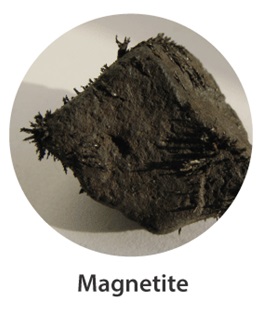
Discovery of Magnets
Greeks used the term magnet in six hundred B.C. for the mysterious stone that seemed to attract iron and other materials. It was first discovered by a Greek shepherd named Magnes (hence the terminology), when his stick that had an iron end got stuck to a rock.
Magnetic and non-magnetic materials
- Materials that get attracted towards a magnet are called magnetic materials. E.g. iron, cobalt or nickel.
- Materials that do not get attracted by a magnet are nonmagnetic materials. E.g. wood, plastic etc.
Poles of a Magnet
Every magnet is bipolar, i.e. they have 2 poles at the extremities. This can be seen by spreading iron filings around a magnet. These filings arrange themselves in a pattern which is mostly dense towards the two ends of a magnet. These poles are called North and South poles of a magnet.
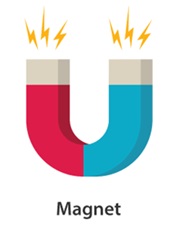
Magnetic poles of the Earth
- Earth has 2 geographic poles, north and south poles.
- They are the Arctic (South pole of the earth’s magnet) and Antarctica (North Pole of the earth’s magnet).
- Earth’s magnetic poles are near but not exactly in the same place as the geographic poles.
- A magnetic compass aligns itself towards the magnetic north pole of the earth.
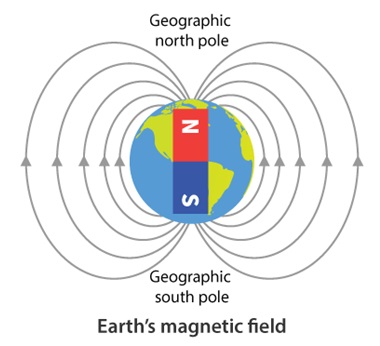
Using magnets to find directions
- When a bar magnet is suspended freely by a thread, it aligns itself to the direction of North.
- Travellers have used this property of magnets for ages to find directions.
- A compass is a device with a magnetised needle pivoted inside a box covered by glass, which points to the direction of north and is a useful tool for finding directions.
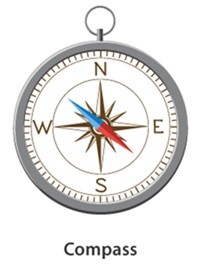
Steps to make own Magnet
- Take a rectangular piece of iron. Place it on the table.
- Take a bar magnet and place one of its poles near one edge of the bar of iron. Without lifting the bar magnet, move it along the length of the iron bar till it reaches the other end.
- Lift the magnet and bring the pole (the same pole we started with) to the same point of the iron bar from which we began. Move the magnet again along the iron bar in the same direction as we did before.
- Repeat this process about 30-40 times. The iron piece has become bar magnet.
Attraction and Repulsion among Magnets
- Opposite or unlike poles i.e. North and the South Pole attract each and vice versa.
- Similar or like poleslike north and north poles of two magnets repel each other. Same is the case with South poles of two magnets.
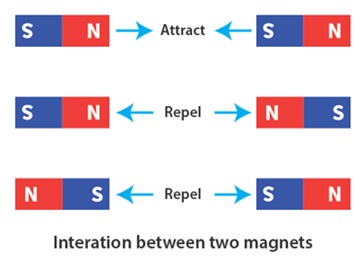
Microscopic cause of magnetism
- Each particle in a magnetic material behaves somewhat like a bar magnet.
- They are normally aligned randomly within the material.
- But under the influence of a stronger magnet, they realign themselves according to the stronger magnet’s field.
Loss of magnetic property
The magnetic property of a magnet is lost on:
- Heating
- Hammering or hitting
- Dropping
Inseparable Poles
- Magnetic poles always exist in pairs.
- If you cut a bar magnet in half, it forms 4 poles, each half having a north and a south pole.
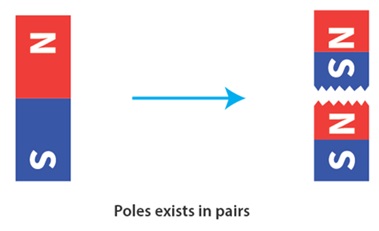
Notes of caution
- When heated, hammered or dropped from a height, magnets tend to lose their properties.
- They become weak if they are not stored properly and hence:
- Bar magnets should be stored in pairs separated by a small block of wood and their unlike poles facing the same side with a soft iron across their ends.
- A piece of iron should be kept across the poles in case of a horseshoe magnet.
- Magnets should be kept away from computers, mobiles, televisions etc.
- Magnets should be handled with care and they should be stored properly
Revision Notes for CBSE Class 6 Science Chapter 13 – Free PDF Download
Our Class 6 Revision Notes will provide a quick glimpse of the chapter and improve the learning experience. We have made these revision notes keeping the convenience of students in mind so that it proves more effective. You can easily read these Class 6 notes just by clicking on the chapter names provided above.